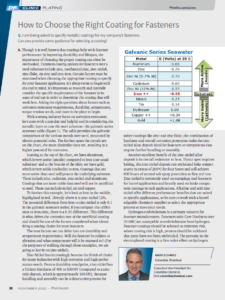Technical & Safety Data
Log in or sign up to access technical data, safety data, applicator approvals and troubleshooting guides.
Mark Schario, Chief Technology Officer at Columbia Chemical, discusses how to choose the right coating for fasteners. #asktheexpert
Products Finishing
Expert Clinic/Plating
Mark Schario, Chief Technology Officer ~ Columbia Chemical
Q. I am being asked to specify metallic coatings for my company’s fasteners. Can you provide some guidance for selecting a coating?
A. Though it is well known that coatings help with fastener performance by improving durability and lifespan, the importance of choosing the proper coating can often be overlooked. Common coating options for fasteners over a steel substrate include zinc, mechanical zinc, zinc-nickel, zinc-flake, tin-zinc and zinc-iron. Certain factors must be examined when choosing the appropriate coating to specify for your fastener application. It’s always wise to begin with the end in mind. It’s important to research and carefully consider the specific requirements of the fastener in its state of end use in order to determine the coating that will work best. Asking the right questions about factors such as corrosion resistance requirements, durability, temperature, torque tension needs, and more is the place to begin.
With a strong industry focus on corrosion resistance, let’s start with a popular and helpful tool in considering the metallic layer to coat the steel substrate: the galvanic series seawater table (figure 1). The table provides the galvanic comparison of the various metals over steel, measured by electro potential volts. The farther apart the metals are on the chart, the more dissimilar they are, resulting in a higher potential for corrosion.
Starting at the top of the chart, we have aluminum, which is very active (anodic) compared to iron (our usual substrate) and at the bottom of the slide, we have gold, which is very noble (cathodic) to iron. Coatings that are more active than steel will protect the underlying substrate. These include zinc, cadmium, zinc-nickel and aluminum. Coatings that are more noble than steel will not be sacrificial to steel. These can include nickel, tin and copper.
The next factors we can delve into are durability and temperature requirements. Will the fastener be subject to abrasion and what temperature will it be exposed to? (For the purposes of walking through these examples, we are going to key in on zinc-nickel).
Another excellent benefit of the zinc-nickel alloy deposit is its overall resistance to heat. If your spec requires baking, the zinc-nickel deposit can withstand bake temperatures in excess of 200°C for four hours and still achieve 800 hours of neutral salt spray protection to first red rust. Zinc-nickel is commonly used on stampings and fasteners for barrel applications and heavily used on brake component castings in rack applications. Alkaline and acid zinc nickel offer different performance benefits that are suited to specific applications, so be sure to work with a knowledgeable chemistry supplier to select the appropriate process to meet your needs.
Finally, let’s look at considerations related to passivate needs and torque tension. Trivalent passivates (conversion coatings) provide protection from white corrosion products and extend hours to red base metal corrosion. They can address appearance factors needed as they provide colors ranging from clear to blue to iridescent to black. The thickness of the passivate can determine the color with a general rule of thumb being 1 nanometer of thickness provides one hour to first white rust. Sealers can be added on top of the passivate layer to provide additional salt spray, provide gloss when needed, and can provide some lubricity.
More and more fastener coatings are being required to fulfill specified tightening characteristic requirements with the use of an automatic machine to perform the tightening, at a specified speed and to specified torques. The torque tension testing equipment tests the integrity of the finished fasteners, ensuring they will tighten consistently without breakage or vibration. Specialized testing equipment has the capability to determine torque and angle, clamping force, head friction, yield point, fracture breaking and other parameters. It also allows the calculation of the coefficient of friction, which provides a more detailed analysis of the torque and tension relationship. This information is critical to OEMs and manufacturers with regard to safety limits.
There are additional factors a materials and coatings engineer, or OEM will take into consideration, such as cost, size, etc., but corrosion resistance, durability, temperature, and torque tension needs are some of the initial factors to be considered when identifying a coating for fasteners.
This article was published in the November 2022 issue of Products Finishing magazine.